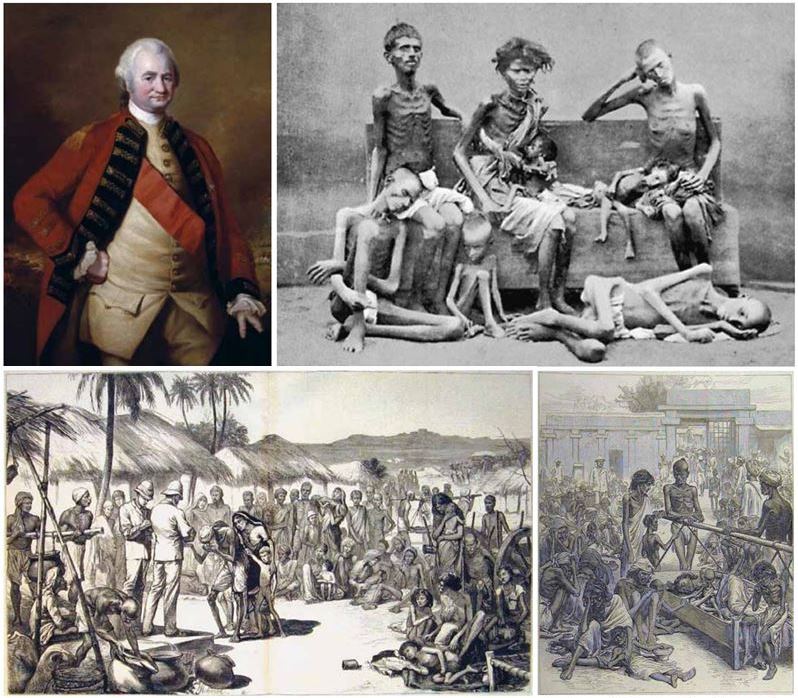The chronic want of food and water, the lack of sanitation and medical help, the neglect of means of communication, the poverty of educational provision, the all-pervading spirit of depression that I have myself seen to prevail in our villages after over a hundred years of British rule make me despair of its beneficence. — Rabindranath Tagore
If the history of British rule in India were to be condensed to a single fact, it is this: there was no increase in India’s per-capita income from 1757 to 1947.[1]
Churchill, explaining why he defended the stockpiling of food within Britain, while millions died of starvation in Bengal, told his private secretary that “the Hindus were a foul race, protected by their mere pullulation from the doom that is their due.”[2]
June 27 — During its 190 years of looting and pillaging, the Indian Subcontininent as a whole underwent at least two dozen major famines, which collectively killed millions of Indians throughout the length and breadth of the land. How many millions succumbed to the famines cannot be fully ascertained. However, colonial rulers’ official numbers indicate it could be 60 million deaths.
In reality, it could be significantly higher.

British colonial analysts cited droughts as the cause of fallen agricultural production that led to these famines, but that is a lie. British rulers, fighting wars in Europe and elsewhere, and colonizing parts of Africa, were exporting grains from India to keep up their colonial conquests—while famines were raging.
People in the famineaffected areas, resembling skeletons covered by skin only, were wandering around, huddling in corners and dying by the millions. The Satanic nature of these British rulers cannot be overstated.
A Systematic Depopulation Policy
Although no accurate census figure is available, in the year 1750 India’s population was close to 155 million. At the time British colonial rule ended in 1947, undivided India’s population reached close to 390 million. In other words, during these 190 years of colonial looting and organized famines, India’s population rose by 240 million.
Since 1947, during the next 68-year period, Indian Subcontininent’s population, including those of India, Pakistan, and Bangladesh, has grown to close to 1.6 billion. Thus, despite poverty and economic depravity in the post-independent Indian Subcontininent, during those 68 years population has grown by almost 1.2 billion.
Records show that during the post-independence period, the Subcontininent has undergone drought conditions in parts of the land from time to time, but there was no famine, although thousands still die in the Subcontininent annually due to the lack of adequate amount of food, a poor food distribution system, and lack of sufficient nourishment. It is also to be noted that before the British colonials’ jackboots got firmly planted in India, famines had occurred but with much less frequency — maybe once in a century.
There was indeed no reason for these famines to occur They occurred only because The Empire engineered them, intending to strengthen the Empire by ruthless looting and adoption of an unstated policy to depopulate India. This, they believed would bring down the Empire’s cost of sustaining India.
Take, for instance, the case of Bengal, which is in the eastern part of the Subcontininent where the British East India Company (HEIC, Honorable East India Company, according to Elizabeth I’s charter) had first planted its jackboots in 1757.
The rapacious looters, under the leadership of Robert Clive — a degenerate and opium addict, who blew his brains out in 1774 in the London Berkley Square residence he had procured with the benefits of his looting — got control of what is now West Bengal, Bangladesh, Bihar, and Odisha (earlier, Orissa), in 1765.
At the time, historical records indicate India represented close to 25% of the world’s GDP, second only to China, while Britain had a paltry 2%. Bengal was the richest of the Indian provinces.
Following his securing control of Bengal by ousting the Nawab in a devious battle at Plassey (Palashi), Clive placed a puppet on the throne, paid him off, and negotiated an agreement with him for the HEIC to become the sole tax collector, while leaving the nominal responsibility for government to his puppet.
That arrangement lasted for a century, as more and more Indian states were bankrupted to facilitate future famines. The tax money went into British coffers, while millions were starved to death in Bengal and Bihar.
Clive, who was made a Fellow of the Royal Society in 1768 and whose statue stands near the British Empire’s evil center, Whitehall, near the Cabinet War Room, had this to say in his defense when the British Parliament, playing “fair,” accused him of looting and other abuses in India:
Consider the situation which the Victory of Plassey had placed on me. A great Prince was dependent upon my pleasure; an opulent city lay at my mercy; its richest bankers bid against each other for my smiles; I walked through vaults which were thrown open to me alone, piled on either hand with gold and jewels! By God, Mr. Chairman, at this moment I stand astonished at my own moderation.
However, Clive was not the only murderous British colonial ruler. The British Empire had sent one butcher after another to India, all of whom engineered looting and its consequent depopulation.
By 1770, when the first great famine occurred in Bengal, the province had been looted to the core. What followed was sheer horror. Here is how John Fiske in his American Philosopher in the Unseen World depicted the Bengal famine:
All through the stifling summer of 1770 the people went on dying. The husbandmen sold their cattle; they sold their implements of agriculture; they devoured their seed-grain; they sold their sons and daughters, till at length no buyer of children could be found; they ate the leaves of trees and the grass of the field….
The streets were blocked up with promiscuous heaps of the dying and dead. Interment could not do its work quick enough; even the dogs and jackals, the public scavengers of the East, became unable to accomplish their revolting work, and the multitude of mangled and festering corpses at length threatened the existence of the citizens…. [3]
Was there any reason for the famine to occur? Not if the British had not wanted it. Bengal, then, as now, harvested three crops a year. It is located in the delta of the Gangetic plain where water is more than plentiful. Even if drought occurs, it does not destroy all three crops.
Moreover, as was prevalent during the Moghul days, and in earlier time, the surplus grain was stored to tide the population over if there were one or two bad crops.
But the looting of grains carried out by Clive, and his gang of bandits and killers, drained grain from Bengal and resulted in 10 million deaths in the great famine, eliminating one-third of Bengal’s population.
It should be noted that Britain’s much-touted industrial revolution began in 1770, the very same year people were dying all over Bengal. The Boston Tea Party that triggered the American Revolution had taken place in 1773. The Boston Tea Party made the Empire realize that its days in America were numbered, and led Britain to concentrate even more on organizing the looting of India.
Why Famines Became So Prevalent During the British Raj Days
The prime reason why these devastating famines took place at a regular intervals, and were allowed to continue for years, was the British Empire’s policy of depopulating its colonies. If these famines had not occurred, India’s population would have reached a billion people long before the Twentieth Century arrived. That, the British Empire saw as a disaster.
To begin with, a larger Indian population would mean larger consumption by the locals, and deprive the British Raj to a greater amount of loot. The logical way to deal with the problem was to develop India’s agricultural infrastructure. But that would not only force Britain to spend more money to run its colonial and bestial empire; it would also develop a healthy population which could rise up to get rid of the abomination called the British Raj.
These massive famines also succeeded in weakening the social structure and backbone of the Indians, making rebellions against the colonial forces less likely. In order to perpetuate famines, and thus depopulate the “heathen” and “dark” Indians, the British imperialists launched a systematic propaganda campaign. They propped up the fraudster Parson Thomas Malthus and promoted his non-scientific gobbledygook, “The Essay on Population.” There he claimed:
This natural inequality of the two powers of population and of production in the earth, and that great law of our nature which must constantly keep their effects equal, form the great difficulty that to me appears insurmountable in the way to the perfectibility of society. All other arguments are of slight and subordinate consideration in comparison of this. I see no way by which man can escape from the weight of this law which pervades all animated nature.
Although Malthus was ordained in the Anglican Church, British Empire made him a paid “economist” of the British East India Company, which, with the charter from Queen Elizabeth I under its belt, monopolized trade in Asia, colonizing vast tracts of the continent using its well-armed militia fighting under the English flag of St. George.
Malthus was picked up at the Haileybury and Imperial Service College, which was also the recruiting ground of some of the worst colonial criminals. This college was where the makers of British Empire’s murderous policies in India were trained.
Some prominent alumni of Haileybury include Sir John Lawrence (Viceroy of India from 1864-68) and Sir Richard Temple (Lt. Governor of Bengal and later, Governor of Bombay presidency).
While Parson Malthus was putting forward his sinister “scientific theory” to justify depopulation as a natural and necessary process, The British Empire collected a whole bunch of other “economists” who wrote about the necessity of free trade. Free trade played a major role in pushing through the Empire’s genocidal depopulation of India, through the British Raj’s efforts. In fact, free trade is the other side of the Malthus’ population-control coin.
By the time the great famine of 1876 arrived, Britain had already built some railroads in India. The railroads, which were touted as institutional safeguards against famines, were instead used by merchants to ship grain inventories from outlying drought-stricken districts to central depots for hoarding.
In addition, free traders’ opposition to price control ushered in a frenzy of grain speculation. As a result, capital was raised to import grains from drought-stricken areas, and further the calamity. The rise of price of grain was spectacularly rapid, and grain was taken from where it was most needed, to be stored in warehouses until the prices rose even higher.
The British Raj knew or should have known. Even if the British rulers did not openly encourage this process, they were fully aware of it, and they were perfectly comfortable in promoting free trade at the expense of millions of lives. This is how Mike Davis described what happened:
The rise [of prices] was so extraordinary, and the available supply, as compared with well-known requirements, so scanty that merchants and dealers, hopeful of enormous future gains, appeared determined to hold their stocks for some indefinite time and not to part with the article which was becoming of such unwonted value.
It was apparent to the Government that facilities for moving grain by the rail were rapidly raising prices everywhere, and that the activity of apparent importation and railway transit, did not indicate any addition to the food stocks of the Presidency… retail trade up-country was almost at a standstill. Either prices were asked which were beyond the means of the multitude to pay, or shops remained entirely closed.
At the time, Lord Lytton, a favorite poet of Queen Victoria who is known as a “butcher” to many Indians, was the Viceroy. He wholeheartedly opposed all efforts to stockpile grain to feed the famine-stricken population because that would interfere with market forces.
In the autumn of 1876, while the monsoon crop was withering in the fields of southern India, Lytton was absorbed in organizing the immense Imperial Assemblage in Delhi to proclaim Victoria Empress of India.
How did Lytton justify this? He was an avowed admirer and follower of Adam Smith. Author Mike Davis writes that Smith, “a century earlier in The Wealth of Nations had asserted (vis-à-vis the terrible Bengal droughtfamine of 1770) that famine has never arisen from any other cause but the violence of government attempting, by improper means, to remedy the inconvenience of dearth, Lytton was implementing what Smith had taught him and other believers of free trade.
“Smith’s injunction against state attempts to regulate the price of grain during the 1770 famine had been taught for years in the East India Company’s famous college at Haileybury.” [4]
Lytton issued strict orders that “there is to be no interference of any kind on the part of Government with the object of reducing the price of food,” and “in his letters home to the India Office and to politicians of both parties, he denounced ‘humanitarian hysterics’.”
By official diktat, India, like Ireland before it, had become a Utilitarian laboratory where millions of lives were gambled, pursuant to dogmatic faith in omnipotent markets overcoming the “inconvenience of dearth.”[5]
The Great Famines
Depicting the two dozen famines that killed more than 60 million Indians would require a lot of space, so I limit myself here to those that killed more than one million:
The Bengal Famine of 1770: This catastrophicfamine occurred between 1769 and 1773, and affected the lower Gangetic plain of India.
The territory, then ruled by the British East India Company, included modern West Bengal, Bangladesh, and parts of Assam, Orissa, Bihar, and Jharkhand. The famine is supposed to have caused the deaths of an estimated 10 million people, approximately one-third of the population at the time.
The Chalisa Famine of 1783-84: The Chalisa famine affected many parts of North India, especially the Delhi territories, present-day Uttar Pradesh, Eastern Punjab, Rajputana (now named, Rajasthan), and Kashmir, then all ruled by different Indian rulers.
The Chalisa was preceded by a famine in the previous year, 1782-83, in South India, including Madras City (now named Chennai) and surrounding areas (under British East India Company rule), and in the extended Kingdom of Mysore. Together, these two famines had taken at least 11 million lives, reports indicate.
The Doji Bara Famine (or Skull Famine) of 1791- 92: This famine caused widespread mortality in Hyderabad, Southern Maratha Kingdom, Deccan, Gujarat, and Marwar (also called Jodhpur region in Rajasthan). The British policy of diverting food to Europe, of pricing the remaining grain out of reach of native Indians, and adopting agriculture policy that destroyed food production, was responsible for this one.
The British had surplus supplies of grain, which was not distributed to the very people that had grown it. As a result, about 11 million died between 1789-92 of starvation and accompanying epidemics that followed.
The Upper Doab Famine of 1860-61: The 1860-61 famine occurred in the British-controlled Ganga-Yamuna Doab (two waters, or two rivers) area engulfing large parts of Rohilkhand and Ayodhya, and the Delhi and Hissar divisions of the then-Punjab. Eastern part of the princely state of Rajputana. According to “official” British reports, about two million people were killed by this famine.
The Orissa Famine of 1866: Although it affected Orissa the most, this famine affected India’s east coast along the Bay of Bengal stretching down south to Madras, covering a vast area. One million died, according to the British “official” version.
The Rajputana famine of 1869: The Rajputana famine of 1869 affected an area of close to 300,000 square miles which belonged mostly to the princely states and the British territory of Ajmer. This famine, according to “official” British claim, killed 1.5 million.
The Great Famine of 1876-78: This famine killed untold numbers of Indians in the southern part and raged for about four years. It affected Madras, Mysore, Hyderabad and Bombay (now called, Mumbai).
The famine also subsequently visited Central Province (now called, Madhya Pradesh) and parts of undivided Punjab. The death toll from this famine was in the range of 5.5 million people. Some other figures indicate the number of deaths could be as high as 11 million.
Indian famine of 1896-97 and 1899-1900: This one affected Madras, Bombay, Deccan, Bengal, United Provinces (now called, Uttar Pradesh), Central Provinces, Northern and eastern Rajputana, parts of Central India, and Hyderabad: six million reportedly died in British territory during these two famines. The number of deaths occurred in the princely states is not known.
The Bengal Famine of 1943-44: This Churchill-orchestrated famine in Bengal in 1943-1944 killed an estimated 3.5 to 5 million people.
Relief Camps, or Concentration camps
There were several policy-arrows which Adolf Hitler might have borrowed from the British quiver to kill millions, but one that he borrowed for certain in setting up his death camps, was how the British ran the camps to provide “relief” to the starving millions. Anyone who entered these relief camps, did not exit alive.
Take the actions of Viceroy Lytton’s deputy, Richard Temple, another Haileybury product imbued with the doctrine of depopulation as the necessary means to keep the Empire strong and vigorous. Temple was under orders from Lytton to make sure there was no “unnecessary” expenditure on relief works.
According to some analysts, Temple’s camps were not very different from Nazi concentration camps. People already half-dead from starvation had to walk hundreds of miles to reach these relief camps. Additionally, he instituted a food ration for starving people working in the camps, which was less than that was given to the inmates of Nazi concentration camps.
The British refused to provide adequate relief for famine victims on the grounds that this would encourage indolence. Sir Richard Temple, who was selected to organize famine relief efforts in 1877, set the food allotment for starving Indians at 16 ounces of rice per day — less than the diet for inmates at the Buchenwald concentration camp for the Jews in Hitler’s Germany.
British disinclination to respond with urgency and vigor to food deficits resulted in a succession of about two dozen appalling famines during the British occupation of India. These swept away tens of millions of people. The frequency of famine showed a disconcerting increase in the nineteenth century.[6]
It was deliberate then, and it’s deliberate now.
Reference: Larouchepub.com [.pdf]
Disclaimer: We at Prepare for Change (PFC) bring you information that is not offered by the mainstream news, and therefore may seem controversial. The opinions, views, statements, and/or information we present are not necessarily promoted, endorsed, espoused, or agreed to by Prepare for Change, its leadership Council, members, those who work with PFC, or those who read its content. However, they are hopefully provocative. Please use discernment! Use logical thinking, your own intuition and your own connection with Source, Spirit and Natural Laws to help you determine what is true and what is not. By sharing information and seeding dialogue, it is our goal to raise consciousness and awareness of higher truths to free us from enslavement of the matrix in this material realm.
 EN
EN FR
FR






























HI CECILLE no no no Guide Stones is also planed deception,same like religion it gives hope to gullible.They do not want any of us hybrids as we are faulty design,created by evil Enki.We are not humans as we like to indulge in our selves,brainwashed by religion,that we are Gods creation.We are half alien in body shape and half animal in regard to our digestive and reproductive system.That’s how we have R.H. factor in our blood,which stand for Rhesus Monkey.World population have 85% R.H.positive population,there is only 15% of us R.H.negative.These R.H. positive do have herd mentality,follow each other,do same,talk same,think same,fight for female,kill each other,and some prefer sex with animals.So there is very slim hope that these H.R. positives would ever wake up,at the delight of N.W.O. and Georgia Guide stones.To claim that God created us it would be not only insult to God it would be equivalent to say that Rolls Royce is making worst car in Europe TRABANT.It would be an insult to that silver lady on the bonnet of finest car in the World.Real history is hidden from us and it is not first and last time since this so called humanity was replaced.There are new design human puppets among us and sheeple does not notice.What we have to realize that this planet we live on is like farm do you think that farmer which is Alien in our case would allow his cattle to destroy his farm.Of course not,we have been forced by those in the know as we are not physical beings we are spiritual beings,and they have great enjoyment from our suffering.Study Inquisition for answers who is ruling us.I never had feelings that I’m from here and could not wait to go back to spiritual form.
This is the elite’s plan for all of us (Well, except for 500 million of the population according to the Georgia Guidestones).
Hi,
I came across those types of people in Denver, Colorado: my partner’s ex-wife ( Marianne) ( she is Mexican-American). Her two adult children from my partner’s previous marriage ( the son is 36yrs. his daughter is 40yrs.) They imitate their mother’s speeches & copy their mother’s lifestyle on choices: food ( Walmart) & go to cheap stores. Then when my partner’s children visit their Dad: they start buying the type of groceries etc. ( they’re college students for over ten years etc.
They can’t be independent. Herd mentality.